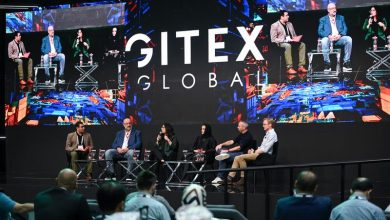SHENZHEN, China, Oct. 23, 2025 /PRNewswire/ — MicroCloud Hologram Inc. (NASDAQ: HOLO), (“HOLO” or the “Company”), a technology service provider, proposed an improved quantum Grover algorithm for a complete new technical solution for dynamic multi-mode search on reconfigurable hardware. This technology has achieved breakthrough progress at both the theoretical design and hardware verification levels, realizing efficient simulation of up to 22 qubits on a single FPGA platform, and verifying scalability to 32 qubits through a performance prediction model, providing a verifiable engineering path for quantum acceleration oriented towards multi-mode data search.
The dynamic multi-mode Grover search algorithm proposed by HOLO breaks through the limitations of single-target search in its design concept. Through the reconstruction of the quantum circuit structure and the introduction of reconfigurable logic, the search operator and oracle construction can be dynamically adjusted during runtime to support multi-mode matching. This design allows quantum search to no longer be limited to a single target state but to flexibly switch between multiple target modes, achieving dynamic mode parallel amplification.
The core of this improvement does not lie in simply increasing the number of searches but in introducing dynamically variable phase control logic at the orchestration level of the quantum circuit. HOLO, through modular design, enables the quantum oracle (target recognition module) and diffusion operator (amplitude amplification module) to be implemented on FPGA logic units in a dynamically loaded manner, thereby supporting multi-mode operations at the hardware execution level. This innovative structure allows the quantum search process to run simultaneously in multiple mode spaces, significantly enhancing the algorithm’s application flexibility and search efficiency.
In the traditional Grover algorithm, the entire circuit includes four stages: initialization, oracle operation, diffusion operation, and measurement, each of which requires building a complete computational path at the quantum gate level. When facing multi-target or dynamic target modes, the traditional circuit needs to regenerate the oracle circuit for each target, leading to resource waste and execution delays. HOLO’s solution, through strategies of circuit simplification and module reuse, has redesigned the circuit system architecture.
First, in the oracle design, HOLO introduced the concept of “dynamic phase modulation”, abstracting the target matching logic into a configurable lookup table (Configurable Lookup Table, CLUT), enabling the oracle to perform mode switching based on input control signals without recompiling the circuit. In this way, the hardware circuit can dynamically modify the search target during the runtime process, achieving true multi-mode search.
Second, in the diffusion operator design, HOLO adopted a hierarchical control method for qubits, implementing a unified amplitude inversion module through reconfigurable logic elements (Reconfigurable Logic Element, RLE). This module dynamically selects the quantum states participating in the inversion via control signals, thereby ensuring that searches under multi-mode conditions can all be completed in the same circuit path. This method greatly reduces the redundant parts of the circuit, making the overall gate depth and wiring complexity significantly decrease.
Finally, HOLO adopted a hardware-level entanglement optimization strategy, enabling the circuit to automatically balance entanglement operations and wiring overhead during the mapping process in FPGA logic blocks. Through dynamic rearrangement of the coupling relationships between qubits, HOLO effectively reduces circuit latency and hardware power consumption, achieving efficient mapping of 22 qubits on resource-limited FPGAs.
At the hardware level, HOLO selected high-performance Field Programmable Gate Arrays (FPGA). The reconfigurable characteristics of FPGA make it naturally suitable for the simulation and verification of quantum algorithms. The reconfigurable architecture mainly includes the following three core modules: quantum state register array, quantum gate control logic, and oracle-diffusion joint execution module.
The quantum state register array achieves parallel storage and update of quantum states through a multi-level register chain structure, supporting state vector storage of up to 22 qubits. Through the pipeline scheduling mechanism, high-concurrency execution of multi-level quantum gate operations can be achieved.
The quantum gate control logic part undertakes the timing scheduling task of circuit execution, adopting a micro-instruction style control method, making each quantum gate operation dynamically rearrangable. This mechanism provides the foundation for subsequent multi-mode dynamic adjustments, allowing the controller to load different oracle or diffusion modules in different time slices, thereby achieving quantum mode switching at the hardware level.
The oracle-diffusion joint execution module is one of the core innovations of HOLO this architecture.. Traditional Grover algorithms require alternating execution of oracle and diffusion operations, while HOLO, through the combination of reconfigurable logic, merges the two at the hardware execution level, achieving single-cycle joint execution. This approach not only reduces hardware overhead but also makes the entire search process possess pipelinable characteristics, thereby significantly improving throughput and simulation speed.
Through monitoring and optimization of FPGA resource utilization, HOLO achieved stable operation supporting 22-qubit circuits on a single FPGA chip. This result exceeds previous FPGA quantum simulation records. Furthermore, based on the performance prediction model, it simulates and calculates the resources and time overhead required to support 32 qubits under the same architecture.
This research not only achieves functional extension of the Grover search algorithm at the algorithmic level but also demonstrates the potential of combining quantum algorithms with reconfigurable hardware at the hardware level. By introducing dynamic configurable logic into the quantum algorithm execution framework, HOLO proves the feasibility of still achieving complex quantum search tasks in resource-constrained environments. This holds important significance for future quantum hardware verification, algorithm prototype development, and quantum computing platforms.
From an industrial perspective, the proposal of the dynamic multi-mode Grover search algorithm provides a new acceleration path for high-performance search-type tasks. It can be widely applied in multiple fields such as cryptanalysis, pattern recognition, quantum database retrieval, and optimization problem solving. The dynamic multi-mode Grover algorithm can quickly switch search targets on the same hardware platform, significantly shortening task processing time. In today’s era where quantum computing is gradually moving toward practicalization, this technology represents an important milestone in the transition from theoretical algorithms to actual systems. It is believed that, with further deepening of the research, the dynamic multi-mode Grover search technology will unleash its potential in more fields, becoming a key force in driving quantum computing toward practical use.
About MicroCloud Hologram Inc.
MicroCloud is committed to providing leading holographic technology services to its customers worldwide. MicroCloud’s holographic technology services include high-precision holographic light detection and ranging (“LiDAR”) solutions, based on holographic technology, exclusive holographic LiDAR point cloud algorithms architecture design, breakthrough technical holographic imaging solutions, holographic LiDAR sensor chip design and holographic vehicle intelligent vision technology to service customers that provide reliable holographic advanced driver assistance systems (“ADAS”). MicroCloud also provides holographic digital twin technology services for customers and has built a proprietary holographic digital twin technology resource library. MicroCloud’s holographic digital twin technology resource library captures shapes and objects in 3D holographic form by utilizing a combination of MicroCloud’s holographic digital twin software, digital content, spatial data-driven data science, holographic digital cloud algorithm, and holographic 3D capture technology. MicroCloud focuses on the development of quantum computing and quantum holography, and plans to invest over $400 million in cutting-edge technology sectors, including Bitcoin-related blockchain development, quantum computing technology development, quantum holography development, and the development of derivatives and technologies in artificial intelligence and augmented reality (AR).
For more information, please visit http://ir.mcholo.com/
Safe Harbor Statement
This press release contains forward-looking statements as defined by the Private Securities Litigation Reform Act of 1995. Forward-looking statements include statements concerning plans, objectives, goals, strategies, future events or performance, and underlying assumptions and other statements that are other than statements of historical facts. When the Company uses words such as “may,” “will,” “intend,” “should,” “believe,” “expect,” “anticipate,” “project,” “estimate,” or similar expressions that do not relate solely to historical matters, it is making forward-looking statements. Forward-looking statements are not guarantees of future performance and involve risks and uncertainties that may cause the actual results to differ materially from the Company’s expectations discussed in the forward-looking statements. These statements are subject to uncertainties and risks including, but not limited to, the following: the Company’s goals and strategies; the Company’s future business development; product and service demand and acceptance; changes in technology; economic conditions; reputation and brand; the impact of competition and pricing; government regulations; fluctuations in general economic; financial condition and results of operations; the expected growth of the holographic industry and business conditions in China and the international markets the Company plans to serve and assumptions underlying or related to any of the foregoing and other risks contained in reports filed by the Company with the Securities and Exchange Commission (“SEC”), including the Company’s most recently filed Annual Report on Form 10-K and current report on Form 6-K and its subsequent filings. For these reasons, among others, investors are cautioned not to place undue reliance upon any forward-looking statements in this press release. Additional factors are discussed in the Company’s filings with the SEC, which are available for review at www.sec.gov. The Company undertakes no obligation to publicly revise these forward-looking statements to reflect events or circumstances that arise after the date hereof.
SOURCE MicroCloud Hologram Inc.



